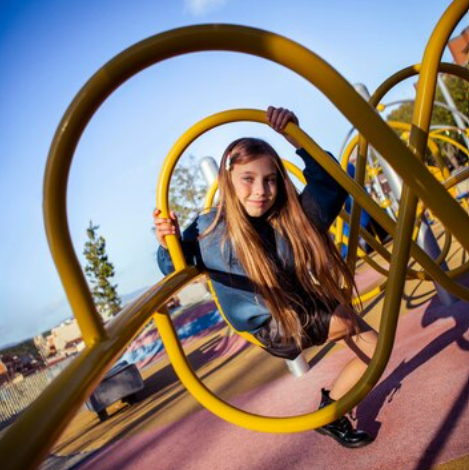What Is The Ideal Springfree Trampoline Shape?

Whereas a Nissen trampoline uses radiating steel spring coils, the Springfree trampoline uses glass-reinforced plastic rods that articulate beneath the jumping surface.
The base’s stiffness comes from a tubular steel structure with angled supports, and the leaping surface is lowered to a point around 450mm below that of a standard trampoline.
Which Trampoline Shape Is Ideal?
Trampolines come in four standard shapes: square, oval, rectangle, and round.
Your experience jumping on the trampoline can be greatly influenced by its shape.
It’s among the most overlooked things to take into account while purchasing a trampoline.
The Four Shapes of Trampoline
As was indicated in the opening, backyard trampolines typically come in four different shapes. Let’s go over each of these in greater depth:
1. Trampolines with circles
The most popular shape of the trampoline is round. Most likely, your childhood trampoline was circular.
They are a great option for novices because of their consistent bounce and innate propensity to draw jumpers back into the center.
Advantages:
- Because of the centralising bounce, it is safer for novices.
- Usually less expensive than other forms.
- Comes in a range of sizes to accommodate different budgets and spaces.
Cons:
- smaller leaping surface area than that of rectangular versions.
- Because of its diminished bounce, advanced jumpers and gymnasts could find it inappropriate.
2. Equilateral Trampolines
Another popular shape for trampolines is the rectangular one, which cheerleaders and gymnasts frequently choose.
They keep the spring distribution uniform, resulting in a stronger bounce and more control over leaps.
Advantages:
- Athletes favor it because of its superior performance bounce.
- provides greater space for acrobatics and flips.
- We do not advise performing advanced techniques.
Cons:
- Rectangular trampolines are usually more expensive because of the materials and construction involved.
- Not as forgiving as the oval ones for inexperienced jumpers.
3. Trampolines in square shapes
Trampolines that are square in shape provide a good compromise between oval and rectangle designs.
Their bounce is similar to that of a rectangular trampoline, but they offer the space-saving advantages of a round trampoline.
Advantages:
- Make the most of your corner-to-corner jumping space.
- Compared to spherical trampolines, their rebound is more consistent.
- fits neatly in confined areas and corners.
Cons:
- Its distinctive shape makes it more costly.
- More popular than other designs of trampolines.
4. Trampolines with oval shapes
Although less prevalent than circular and rectangle trampolines, oval trampolines offer longer jumping surfaces.
It can be used for sports or as a beginner’s trampoline.
Advantages:
- More space for movements and activities is provided by the elongated design.
- For younger children, the bounce is usually gentler than on rectangular or square-shaped trampolines.
- provides space flexibility for backyards that are long and tight.
Cons:
- Because of their unusual shape and lower frequency than other types, they can be costly.
- Possibly needing more yard space than round ones.
How to Pick the Ideal Shape for a Trampoline
Which kind of trampoline you require will depend on the following factors:
Goal:
Ascertain the trampoline’s main function. Is it for gymnastics, fitness, recreational bouncing, or other particular uses?
Available Space:
Take a measurement of the space where the trampoline will be erected to make sure there won’t be any obstacles or too much space for the selected shape.
For safety, we advise leaving three to five feet of area unobstructed around the trampoline.
an illustration showing a Springfree trampoline featuring crosses indicating a five-foot clearance area.
Safety:
Take into account each shape’s safety characteristics. Rectangular trampolines offer greater control over jumping for activities like gymnastics, whereas round trampolines tend to orient users towards the center, lowering the risk of falling off.
Bounce Quality:
Evaluate each shape’s bounce quality. For ordinary recreational use, round trampolines usually provide a milder bounce.
Other designs, such as square and rectangular trampolines, could offer more bounce and the ideal area needed for tumbling and gymnastics.
Budget:
Establish your spending limit while taking the variations in trampoline prices between different designs.
Durability:
Assess each shape’s resilience taking into account elements like the type of spring used, the UV treatment that was applied, and the materials used for the frame.
A well-constructed trampoline can endure years of use and many weather conditions.
1. Which Kind of Trampoline Is Ideal for Children?
We suggest starting your search for a trampoline with an oval or round shape if you have small children.
These trampoline shapes draw jumpers toward the middle of the mat, which is the safest area, giving them a more regulated bounce.
Nonetheless, purchasing a basic square or a rectangle trampoline would be worthwhile if your kid has overtime trampoline aspirations.
This will guarantee that as they become bigger, your kid will have lots of space to leap!
2. What Benefits Can a Square Trampoline Offer?
Square trampolines provide several benefits, including improved corner-to-corner jumping area, more evenly distributed bounce, and plenty of room for several users, if permitted (we advise adhering to the “One Jumper at a Time Rule”).
Because square-shaped trampolines require precise engineering to build, they are frequently more expensive. There aren’t many of them because of their distinctive construction.
3. Which Type of Trampoline Is Safer: Rectangular or Round?
This is dependent on how well the trampoline is constructed.
Because a circular trampoline tends to bring the person jumping to the exact center of the mat, one may claim that it is more secure than a rectangle-shaped trampoline.
On the other hand, a high-quality rectangular trampoline will be safer than a cheap round trampoline, or vice versa.
4. What Size Jump Rope Is Required?
It’s important to consider the design of the trampoline you want in your garden.
Set objectives with the assistance of this article. To start focusing on a shape, start by discussing why you or your children desire a trampoline.
Determining the shape is the first step in determining what type of trampoline you require.
In summary
A unique flexible rod is used in place of springs in springfree trampolines. The rods offer a smooth bounce free of pinch points and are more than three times tougher than steel. Springfree trampolines are made to be low-maintenance, safe, and silent. They also come with an enclosure known as the FlexiNet.
See Also: Überstezet: The Ultimate Translation Tool




